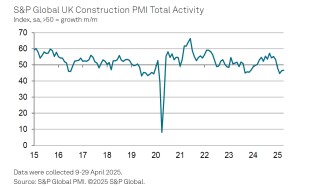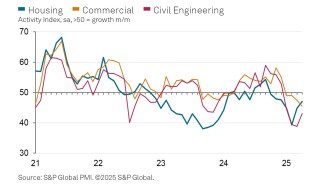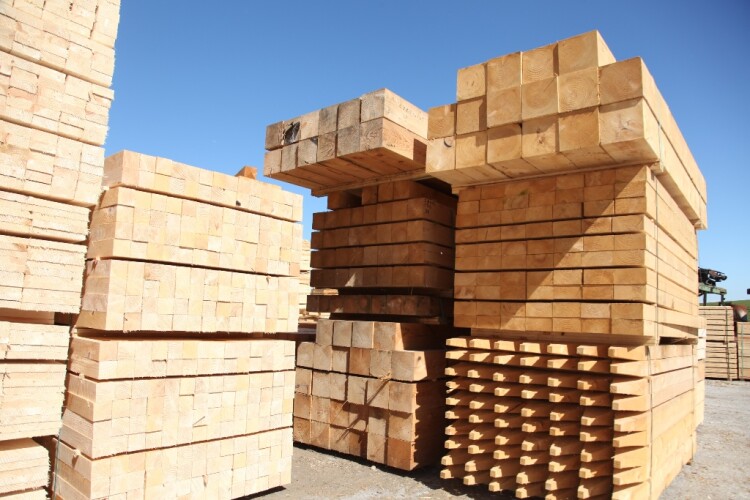This post was originally published on this site
https://www.theconstructionindex.co.uk/assets/news_articles/2025/02/1738841805_timber.jpgUK construction activity decreased for the fourth consecutive month in April as rising business uncertainty led to delayed decision-making on new projects.
That is according to the latest monthly survey of construction purchasing managers, which also indicates further declines in total order books and cutbacks to staffing numbers.
At 46.6 in April, the headline S&P Global UK Construction Purchasing Managers’ Index (PMI) remained below the 50.0 no-change value – it has been in this negative territory every month of 2025 so far – but was at least up slightly from March’s 46.4 reading and February’s 44.6. (The lower the number, the worse things are.)
All three broad categories of the industry – house-building, civil engineering and commercial construction – remain in decline.
The house-building sector’s reading of 47.1 was as good as it has been all year. Civil engineering remained the weakest performer at 43.1 (up from 38.8 in March), with a distinct lack of new work to replace completed projects.
But while house-building and civil engineering have at least moved in the right direction, the decline of commercial work has been accelerating: 49.0 in February, 47.4 March and now 45.5 in April, its worst reading since May 2020. Construction companies widely noted that heightened business uncertainty and worries about the broader UK economic outlook had weighed on client demand.
April data indicated a steep reduction in total new work and the pace of decline was the second-fastest since May 2020. Survey respondents typically commented on the impact of subdued business and consumer confidence.
Lower workloads resulted in the fastest decline in purchasing activity for nearly five years in April. For those with work, however, it has meant materials are easier to source. Wait times for suppliers’ deliveries have now improved in each of the past three months, although some firms continued to report international shipping delays.
Despite weaker demand conditions, latest data indicated another sharp increase in average cost burdens. Construction companies noted that a wide range of items had risen in price, particularly concrete products, insulation and timber, but some firms noted lower fuel costs. Many firms reported that suppliers had also sought to pass on rising payroll costs.
Staffing numbers across the construction sector meanwhile decreased for the fourth consecutive month, but the rate of job shedding eased slightly since March. Subdued demand and rising pay pressures were cited as reasons for the non-replacement of voluntary leavers.

Looking ahead, construction firms are optimistic on balance about their prospects for the next 12 months. Around 41% of the survey panel forecast a rise in output, while only 18% predict a decline. This signalled a slight improvement in business optimism to its highest since December 2024. A number of firms commented on positive expectations for residential building work, despite ongoing domestic economic headwinds and fragile client confidence.

Tim Moore, economics director at S&P Global Market Intelligence, which compiles the monthly survey, said: “UK construction companies have endured a bumpy ride since the start of the year as domestic economic headwinds and hesitancy among clients led to a lack of new work to replace completed contracts.
“Output levels continued to slide in April, but the rate of decline eased to its slowest for three months. This was helped by slower reductions in residential building work and civil engineering activity.
“Commercial construction was a weak spot and lost momentum since March. Output decreased at the fastest pace for nearly five years amid reports of greater risk aversion among clients and a wait-and-see approach to major spending decisions.
“Despite a sharp and accelerated fall in input buying, strong cost pressures persisted in April. Overall input price inflation eased only slightly from March’s 26-month peak. Survey respondents commented on rising prices paid for a range of raw materials, as well as efforts by suppliers to pass on greater payroll costs.
“An encouraging development in April was a slight improvement in business activity expectations for the year ahead. Output growth projections improved to the highest level so far this year, with a number of survey respondents citing the prospect of a turnaround in
workloads across the residential building segment.”

Got a story? Email [email protected]


